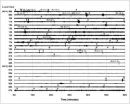(Press-News.org) Synthetic biology is the latest and most advanced phase of genetic engineering, holding great promise for helping to solve some of the world's most intractable problems, including the sustainable production of energy fuels and critical medical drugs, and the safe removal of toxic and radioactive waste from the environment. However, for synthetic biology to reach its promise, the design and construction of biological systems must be as predictable as the assembly of computer hardware.
An important step towards attaining a higher degree of predictability in synthetic biology has been taken by a group of researchers with the U.S. Department of Energy's Lawrence Berkeley National Laboratory (Berkeley Lab) under the leadership of computational biologist Adam Arkin. Arkin and his team have developed an "adaptor" that makes the genetic engineering of microbial components substantially easier and more predictable by converting regulators of translation into regulators of transcription in Escherichia coli. Transcription and translation make up the two-step process by which the coded instructions of genes are used to synthesize proteins.
"Application of our adaptor should produce large collections of transcriptional regulators whose inherent composability can facilitate the predictable engineering of complex biological circuits in microorganisms," Arkin says. "This in turn should allow for safer and more efficient constructions of increasingly complex functions in microorganisms."
Arkin is the director of Berkeley Lab's Physical Biosciences Division and the corresponding author of a paper describing this work in Nature Methods. The paper is titled "An adaptor from translational to transcriptional control enables predictable assembly of complex regulation. Co-authoring this paper were Chang Liu, Lei Qi, Julius Lucks, Thomas Segall-Shapiro, Denise Wang and Vivek Mutalik.
Synthetic biology combines modern principles of science and engineering to develop novel biological functions and systems that can tackle problems natural systems cannot. The focus is on bacteria and other microbes that can metabolize a wide variety of valuable chemicals and molecules, and play a critical role in the global cycles of carbon and other important elements. One of the keys to success in synthetic biology is the design and construction of customized genetic switches in microbes that can control the expression of both coding and non-coding RNA, act on operons (small groups of genes with related functions that are co-transcribed in a single strand of messenger RNA), and be tethered to higher-order regulatory functions (a property called composability).
"Much of the regulatory potential of a bacterium is contained in the five-prime untranslated regions (UTRs), which control the expression of physically adjacent downstream genes and have become attractive plat¬forms for a parts-based approach to synthetic biology," Arkin says. "This approach, in which integrated engineered regulatory parts respond to custom inputs by changing the expression of desired genes, must satisfy two criteria if it is to have long-term success. First, the regulatory parts must be easily engineered in a way that yields large homogenous sets of variants that respond to different custom inputs, and second, the parts must be composable such that they can be easily and predictably assem-bled into useful higher-order functions."
In the five prime UTRs of bacteria, two primary types of regulators can serve as starting points for designing new parts – those that regulate transcriptional elongation, in which cellular inputs are linked to the process by which a sequence of DNA nucleotides is transcribed into a complementary sequence of RNA; and those that regulate translation, in which a ribosome translates the RNA message into a protein. Transcriptional elongation regulators meet the second criterion by featuring versatility and composability that makes them ideal for building custom regulatory functions. Translational regulators meet the first criterion by being easier to engineer and relatively common to all bacteria.
"Our solution for meeting both criteria was to develop an adaptor based on tryptophanase, the catabolic operon for tryptophan that converts regulators of translational initiation into regulators of transcriptional elongation," Arkin says. "Because our adaptor strategy bypasses the otherwise restrictive tradeoff between cri¬terion one and criterion two, we believe it will have a crucial role in the long-term development of five prime UTRs as platforms for the design and integration of custom regulatory parts."
When an E.coli translational regulator was fused to the adaptor created by Arkin and his colleagues, it was also able to control transcriptional elongation. The team applied their adaptor to the construction of several transcrip¬tional elongation regulators that respond to RNA and small-molecule inputs. Included were five mutually orthogonal RNA-triggered attenu¬ators (meaning they can terminate transcription), which the team assembled into logic gates driven by two, three or four RNA inputs that linked to ribosome binding sites. Because their adaptor is so easily linked to ribosome binding sites, a common mechanism in bacteria, the team believes the adaptor will be widely applicable.
"Continued application of our adaptor should produce large collections of transcriptional regulators whose inherent composability can facilitate the predictable engineering of complex synthetic circuits," Arkin says.
The adaptor is ready for use by researchers now, and joins a growing suite of tools created by Arkin's group and their collaborators to make the design and fabrication of microbial systems more reliably predictable.
"Taken together, these tools enable a predictable biological circuit design cycle that dramatically increases the efficiency, safety and sophistication of genetic engineering," Arkin says.
INFORMATION:
In addition to his Berkeley Lab appointment, Arkin also holds appointments with DOE's Joint BioEnergy Institute (JBEI), the University of California (UC) Berkeley, where he directs the Synthetic Biology Institute, a partnership between UC Berkeley and Berkeley Lab, and the California Institute for Quantitative Biological Research (QB3).
This research was supported by the National Science Foundation as part of the Synthetic Biology Engineering Research Center (SynBERC).
Lawrence Berkeley National Laboratory addresses the world's most urgent scientific challenges by advancing sustainable energy, protecting human health, creating new materials, and revealing the origin and fate of the universe. Founded in 1931, Berkeley Lab's scientific expertise has been recognized with 13 Nobel prizes. The University of California manages Berkeley Lab for the U.S. Department of Energy's Office of Science. For more, visit www.lbl.gov.
A welcome predictability
Berkeley Lab researchers develop new tool for making genetic engineering of microbial circuits reliably predictable
2012-10-09
ELSE PRESS RELEASES FROM THIS DATE:
Wireless data at top speed
2012-10-09
Whether it's a wedding, birthday party or other celebration, these days the chances are you'll have your camcorder with you to record the great occasion. But we often forget to bring the data cable along with us, so despite promising the hosts to transfer the images to their computer the morning after, we hardly ever do. "No problem," we say, "I'll burn you a CD when I get home." It would be so much easier, though, to transfer the data wirelessly.
This thought also occurred to Frank Deicke, a researcher at the Fraunhofer Institute for Photonic Microsystems IPMS in Dresden. ...
App protects Facebook users from hackers
2012-10-09
RIVERSIDE, Calif. (www.ucr.edu) — Cyber-crime is expanding to the fertile grounds of social networks and University of California, Riverside engineers are fighting it.
A recent four-month experiment conducted by several UC Riverside engineering professors and graduate students found that the application they created to detect spam and malware posts on Facebook users' walls was highly accurate, fast and efficient.
The researchers also introduced the new term "socware" to describe a combination of "social malware," encompassing all criminal and parasitic behavior on online ...
Fossil of ancient spider attack only 1 of its type ever discovered
2012-10-09
CORVALLIS, Ore. – Researchers have found what they say is the only fossil ever discovered of a spider attack on prey caught in its web – a 100 million-year-old snapshot of an engagement frozen in time.
The extraordinarily rare fossils are in a piece of amber that preserved this event in remarkable detail, an action that took place in the Hukawng Valley of Myanmar in the Early Cretaceous between 97-110 million years ago, almost certainly with dinosaurs wandering nearby.
Aside from showing the first and only fossil evidence of a spider attacking prey in its web, the piece ...
Poorer lung health leads to age-related changes in brain function
2012-10-09
COLUMBUS, Ohio – Keeping the lungs healthy could be an important way to retain thinking functions that relate to problem-solving and processing speed in one's later years, new research suggests.
While these two types of "fluid" cognitive functions were influenced by reduced pulmonary function, a drop in lung health did not appear to impair memory or lead to any significant loss of stored knowledge, the study showed.
Researchers used data from a Swedish study of aging that tracked participants' health measures for almost two decades. An analysis of the data with statistical ...
Computational model IDs potential pathways to improve plant oil production
2012-10-09
UPTON, NY - Using a computational model they designed to incorporate detailed information about plants' interconnected metabolic processes, scientists at the U.S. Department of Energy's Brookhaven National Laboratory have identified key pathways that appear to "favor" the production of either oils or proteins. The research, now published online in Plant Physiology, may point the way to new strategies to tip the balance and increase plant oil production.
The study focused on the metabolism of rapeseed, a crop grown primarily in temperate climates for the oil that accumulates ...
2010 Korea bomb 'tests' probably false alarms, says study
2012-10-09
This spring, a Swedish scientist sparked international concern with a journal article saying that radioactive particles detected in 2010 showed North Korea had set off at least two small nuclear blasts--possibly in experiments designed to boost the yields of much larger bombs. Shortly after, the pot was stirred with separate claims that some intelligence agencies suspected the detonations were done in cooperation with Iran. Now, a new paper says the tests likely never took place—or that if they did, they were too tiny to have any military significance. The new report, ...
'Wonder material' graphene could revolutionize cell phones, solar panels and more
2012-10-09
WASHINGTON, October 8, 2012 — Smart phones almost as thin and flexible as paper and virtually unbreakable. Solar panels molded to cover the surface of an electric or hybrid car. Possible treatments for damaged spinal cords. It's not science fiction. Those all are possible applications of a material known as graphene. This so-called "wonder material," the world's strongest (100 times stronger than steel) and thinnest (one ounce would cover 28 football fields), is the focus of a new episode of the ChemMatters video series. The video is at www.BytesizeScience.com.
The video, ...
A DNA-made trap may explain amyloidosis aggravation
2012-10-09
Rio de Janeiro, Brazil- Amyloidosis is a group of clinical syndromes characterized by deposits of amyloid fibrils throughout the body. These fibrils are formed by aggregates of proteins that have not been properly folded. Deposits of amyloid fibrils are found in a number of diseases, including Alzheimer's and Parkinson's diseases and type-2 diabetes. The amyloid deposits can be localized, as in the brain of Alzheimer's patients, or found spread through the body, as in amyloidosis related to mutations in the transthyretin gene.
The clinical meaning of amyloid deposits ...
Child-free women feel intense pressure to have kids -- but rarely stress over it
2012-10-09
Women who choose to be permanently childfree perceive more social pressures to become mothers than other women, but feel less distress about not having kids than women who are childless from infertility or other reasons, a new national study shows.
The study, from a national survey of nearly 1,200 American women of reproductive age with no children, identified various reasons why women have no children, from medical and situational barriers to delaying pregnancy to choosing to be childfree. It sought to determine if those reasons contributed to different types of concerns ...
Caffeine may block inflammation linked to mild cognitive impairment
2012-10-09
URBANA – Recent studies have linked caffeine consumption to a reduced risk of Alzheimer's disease, and a new University of Illinois study may be able to explain how this happens.
"We have discovered a novel signal that activates the brain-based inflammation associated with neurodegenerative diseases, and caffeine appears to block its activity. This discovery may eventually lead to drugs that could reverse or inhibit mild cognitive impairment," said Gregory Freund, a professor in the U of I's College of Medicine and a member of the U of I's Division of Nutritional Sciences.
Freund's ...
LAST 30 PRESS RELEASES:
Making lighter work of calculating fluid and heat flow
Normalizing blood sugar can halve heart attack risk
Lowering blood sugar cuts heart attack risk in people with prediabetes
Study links genetic variants to risk of blinding eye disease in premature infants
Non-opioid ‘pain sponge’ therapy halts cartilage degeneration and relieves chronic pain
AI can pick up cultural values by mimicking how kids learn
China’s ecological redlines offer fast track to 30 x 30 global conservation goal
Invisible indoor threats: emerging household contaminants and their growing risks to human health
Adding antibody treatment to chemo boosts outcomes for children with rare cancer
Germline pathogenic variants among women without a history of breast cancer
Tanning beds triple melanoma risk, potentially causing broad DNA damage
Unique bond identified as key to viral infection speed
Indoor tanning makes youthful skin much older on a genetic level
Mouse model sheds new light on the causes and potential solutions to human GI problems linked to muscular dystrophy
The Journal of Nuclear Medicine ahead-of-print tip sheet: December 12, 2025
Smarter tools for peering into the microscopic world
Applications open for funding to conduct research in the Kinsey Institute archives
Global measure underestimates the severity of food insecurity
Child survivors of critical illness are missing out on timely follow up care
Risk-based vs annual breast cancer screening / the WISDOM randomized clinical trial
University of Toronto launches Electric Vehicle Innovation Ontario to accelerate advanced EV technologies and build Canada’s innovation advantage
Early relapse predicts poor outcomes in aggressive blood cancer
American College of Lifestyle Medicine applauds two CMS models aligned with lifestyle medicine practice and reimbursement
Clinical trial finds cannabis use not a barrier to quitting nicotine vaping
Supplemental nutrition assistance program policies and food insecurity
Switching immune cells to “night mode” could limit damage after a heart attack, study suggests
URI-based Global RIghts Project report spotlights continued troubling trends in worldwide inhumane treatment
Neutrophils are less aggressive at night, explaining why nighttime heart attacks cause less damage than daytime events
Menopausal hormone therapy may not pose breast cancer risk for women with BRCA mutations
Mobile health tool may improve quality of life for adolescent and young adult breast cancer survivors
[Press-News.org] A welcome predictabilityBerkeley Lab researchers develop new tool for making genetic engineering of microbial circuits reliably predictable


